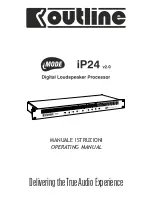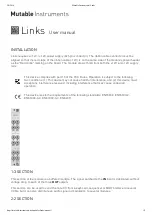
1-16
INTRODUCTION
ORBAN MODEL 8500S
above the separation (approximately 20 dB) that starts to cause perceptible changes
in the stereo image.
You will achieve a louder sound on the air, with better control of peak modulation,
than if you use most external stereo encoders.
An exception is Orban’s 5518 stereo encoder, which does not add overshoot and
contains its own overshoot limiter and composite limiter equivalent to the one in
the 8500S when operated in its stand-alone stereo encoder mode.
The shorter the baseband cable from OPTIMOD-FM to exciter, the less likely that
ground loops or other noise problems will occur in the installation. If you require a
long cable run, you can use a Jensen JT-123-BMCF transformer
loops. This transformer will ordinarily cure even the most stubborn hum or noise
caused by the composite connection between OPTIMOD-FM and the exciter. For
connection instructions, please refer to the Orban CIT25 Composite Isolation Trans-
former schematic diagram, which is shown on page 12 of the CIT25 manual. This is
available from:
no longer manufactures the CIT25, which used the Jensen transformer.)
If a separate stereo encoder must be used, feed the encoder directly from the
8500S’s left and right analog or (preferably) digital outputs. If possible, bypass the
pre-emphasis network and the input low-pass filters in the encoder so that they
cannot introduce spurious peaks. Because of their special design, OPTIMOD-FM’s
pre-emphasis network and low-pass filters perform the same functions while retain-
ing tight peak control.Studio-Transmitter Link
Transmission from Studio to Transmitter
There are five types of studio-transmitter links (STLs) in common use in broadcast
service: uncompressed digital, digital with lossy compression (like MPEG, Dolby
®
, or
APT-x
®
), microwave, analog landline (telephone/post line), and audio subcarrier on a
video microwave STL.
3
Julie M. Adkins and Robert D. Sorkin: “Effect of Channel Separation on Earphone-
Presented Tones, Noise, and Stereophonic Material,”
J. Audio Engineering Society
,
vol. 33 pp. 234-239, 1985.
Subjects listened to 500-Hz tones, broadband noise, and stereophonic program ma-
terial through earphones and adjusted the channel separation, via a manual control,
until the degradation of the spatial effect became detectable. Mean channel separa-
tions ranged from 10 to 15.9 dB for the musical selections employed and from 13.7
to 16.8 dB for the noise and tonal stimuli. The results are discussed in terms of exist-
ing data on detectable stereo separation and on the discrimination of interaural
time differences. [Abstract ©Audio Engineering Society, Inc.]
4
http://www.jensen-transformers.com/wp-content/uploads/2014/08/jt-123-bmcf.pdf
Содержание OPTIMOD-FM 8500S
Страница 1: ...Operating Manual OPTIMOD FM 8500S Digital Audio Processor Version 1 0 Software...
Страница 7: ...Operating Manual OPTIMOD FM 8500S Digital Audio Processor Version 1 0 Software...
Страница 26: ......
Страница 56: ......
Страница 164: ......
Страница 308: ......
Страница 310: ...6 28 TECHNICAL DATA ORBAN MODEL 8500S CONTROL BOARD PARTS LOCATOR...
Страница 316: ...6 34 TECHNICAL DATA ORBAN MODEL 8500S 5700 8600S I O DSP BOARD PARTS LOCATOR DRAWING 32370 860 01...
Страница 321: ...OPTIMOD FM DIGITAL TECHNICAL DATA 6 39 8600S I O BOARD COMPOSITE SCA DAUGHTERBOARD SHEET 4b of 12 62310 000 02 1...
Страница 330: ...6 48 TECHNICAL DATA ORBAN MODEL 8500S FRONT REAR FRONT PANEL PARTS LOCATOR DIAGRAM 32275 000 09...
Страница 334: ...6 52 TECHNICAL DATA ORBAN MODEL 8500S...
Страница 335: ...OPTIMOD FM DIGITAL TECHNICAL DATA 6 53...
















































